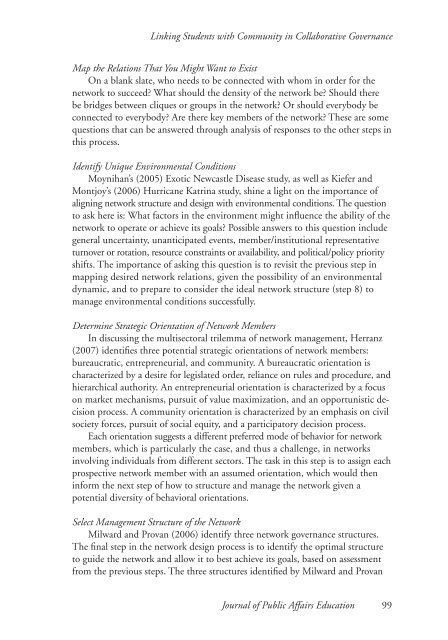Journal of Public Affairs Education
Create successful ePaper yourself
Turn your PDF publications into a flip-book with our unique Google optimized e-Paper software.
Linking Students with Community in Collaborative Governance<br />
Map the Relations That You Might Want to Exist<br />
On a blank slate, who needs to be connected with whom in order for the<br />
network to succeed? What should the density <strong>of</strong> the network be? Should there<br />
be bridges between cliques or groups in the network? Or should everybody be<br />
connected to everybody? Are there key members <strong>of</strong> the network? These are some<br />
questions that can be answered through analysis <strong>of</strong> responses to the other steps in<br />
this process.<br />
Identify Unique Environmental Conditions<br />
Moynihan’s (2005) Exotic Newcastle Disease study, as well as Kiefer and<br />
Montjoy’s (2006) Hurricane Katrina study, shine a light on the importance <strong>of</strong><br />
aligning network structure and design with environmental conditions. The question<br />
to ask here is: What factors in the environment might influence the ability <strong>of</strong> the<br />
network to operate or achieve its goals? Possible answers to this question include<br />
general uncertainty, unanticipated events, member/institutional representative<br />
turnover or rotation, resource constraints or availability, and political/policy priority<br />
shifts. The importance <strong>of</strong> asking this question is to revisit the previous step in<br />
mapping desired network relations, given the possibility <strong>of</strong> an environmental<br />
dynamic, and to prepare to consider the ideal network structure (step 8) to<br />
manage environmental conditions successfully.<br />
Determine Strategic Orientation <strong>of</strong> Network Members<br />
In discussing the multisectoral trilemma <strong>of</strong> network management, Herranz<br />
(2007) identifies three potential strategic orientations <strong>of</strong> network members:<br />
bureaucratic, entrepreneurial, and community. A bureaucratic orientation is<br />
characterized by a desire for legislated order, reliance on rules and procedure, and<br />
hierarchical authority. An entrepreneurial orientation is characterized by a focus<br />
on market mechanisms, pursuit <strong>of</strong> value maximization, and an opportunistic decision<br />
process. A community orientation is characterized by an emphasis on civil<br />
society forces, pursuit <strong>of</strong> social equity, and a participatory decision process.<br />
Each orientation suggests a different preferred mode <strong>of</strong> behavior for network<br />
members, which is particularly the case, and thus a challenge, in networks<br />
involving individuals from different sectors. The task in this step is to assign each<br />
prospective network member with an assumed orientation, which would then<br />
inform the next step <strong>of</strong> how to structure and manage the network given a<br />
potential diversity <strong>of</strong> behavioral orientations.<br />
Select Management Structure <strong>of</strong> the Network<br />
Milward and Provan (2006) identify three network governance structures.<br />
The final step in the network design process is to identify the optimal structure<br />
to guide the network and allow it to best achieve its goals, based on assessment<br />
from the previous steps. The three structures identified by Milward and Provan<br />
<strong>Journal</strong> <strong>of</strong> <strong>Public</strong> <strong>Affairs</strong> <strong>Education</strong> 99



